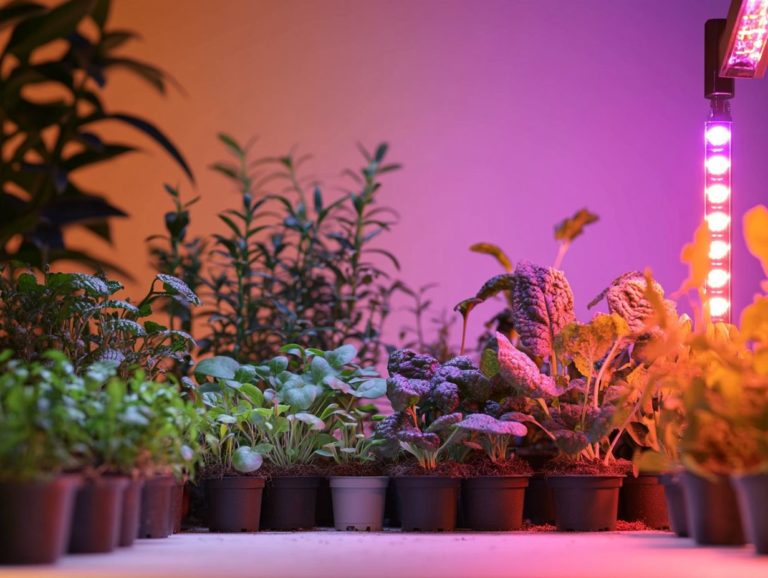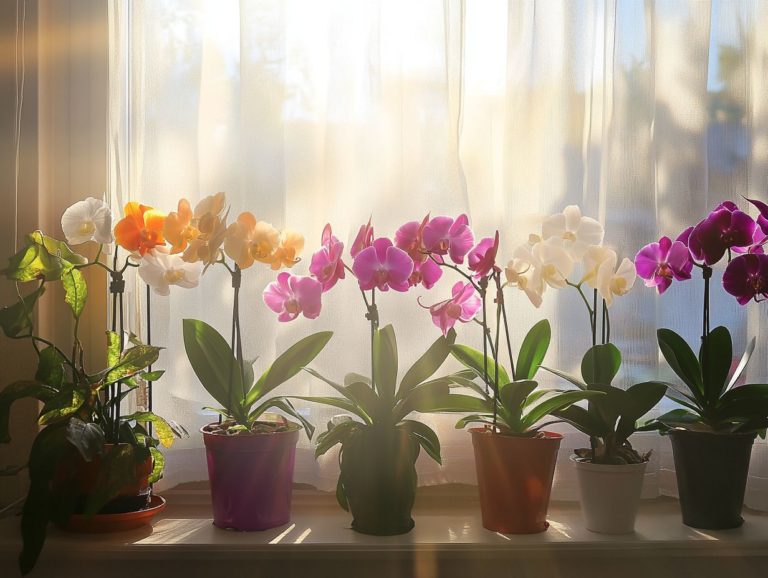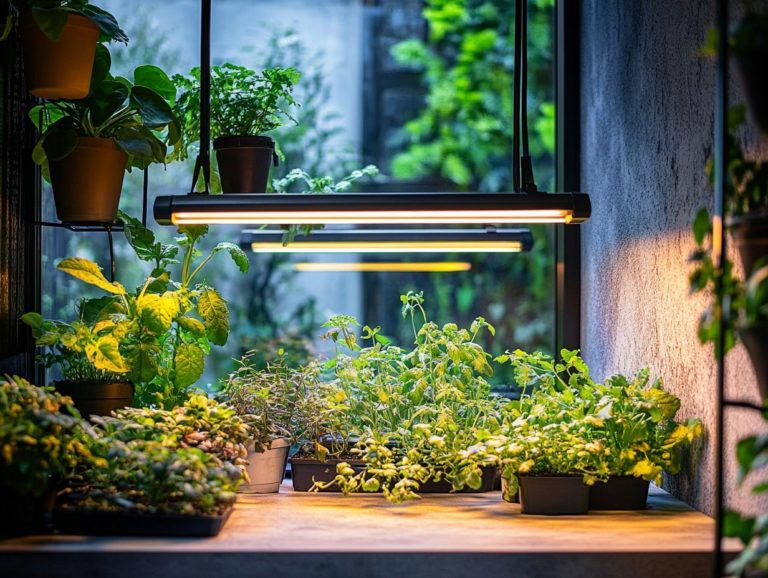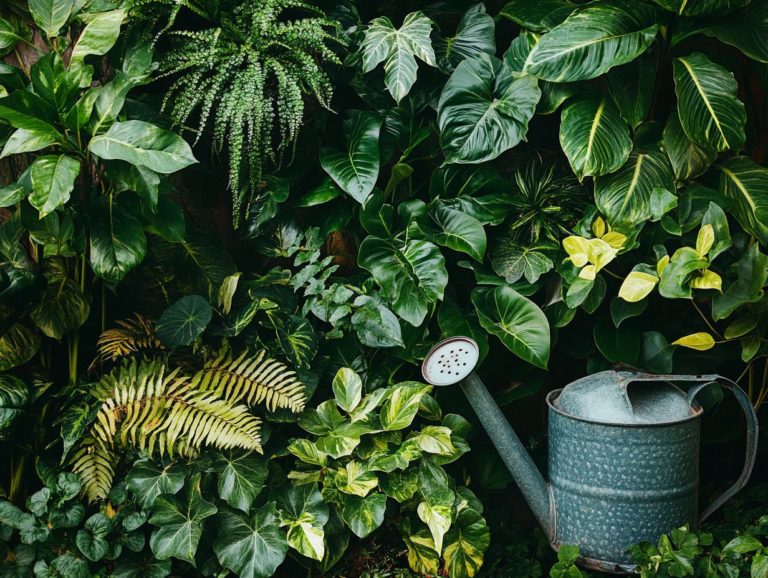How to Measure Light Intensity for Plants
Light intensity is crucial for the health and growth of your plants. It impacts everything from photosynthesis to blooming.
By understanding the intricacies of light and the factors that influence its intensity, you can create an ideal environment for your plants.
This article highlights the significance of light in plant growth. It offers insights on measuring light intensity with tools like light meters and illuminance meters, and outlines optimal conditions for your greenery.
Whether you re a seasoned gardener or just starting, you ll discover practical tips to elevate your green space.
Contents
- Key Takeaways:
- Why Light Intensity is Important for Plants
- Factors Affecting Light Intensity
- Methods for Measuring Light Intensity
- Interpreting Light Intensity Measurements
- Adjusting Light Intensity for Plants
- Tips for Maintaining Optimal Light Intensity
- Frequently Asked Questions
- What is light intensity and why is it important for plants?
- How can I measure light intensity for my plants using a physical light meter?
- What is a good light intensity level for indoor plants?
- How do I use a light meter to measure light intensity for my plants?
- Can I use a smartphone app to measure light intensity for my plants?
- How often should I measure light intensity for my plants?
Key Takeaways:
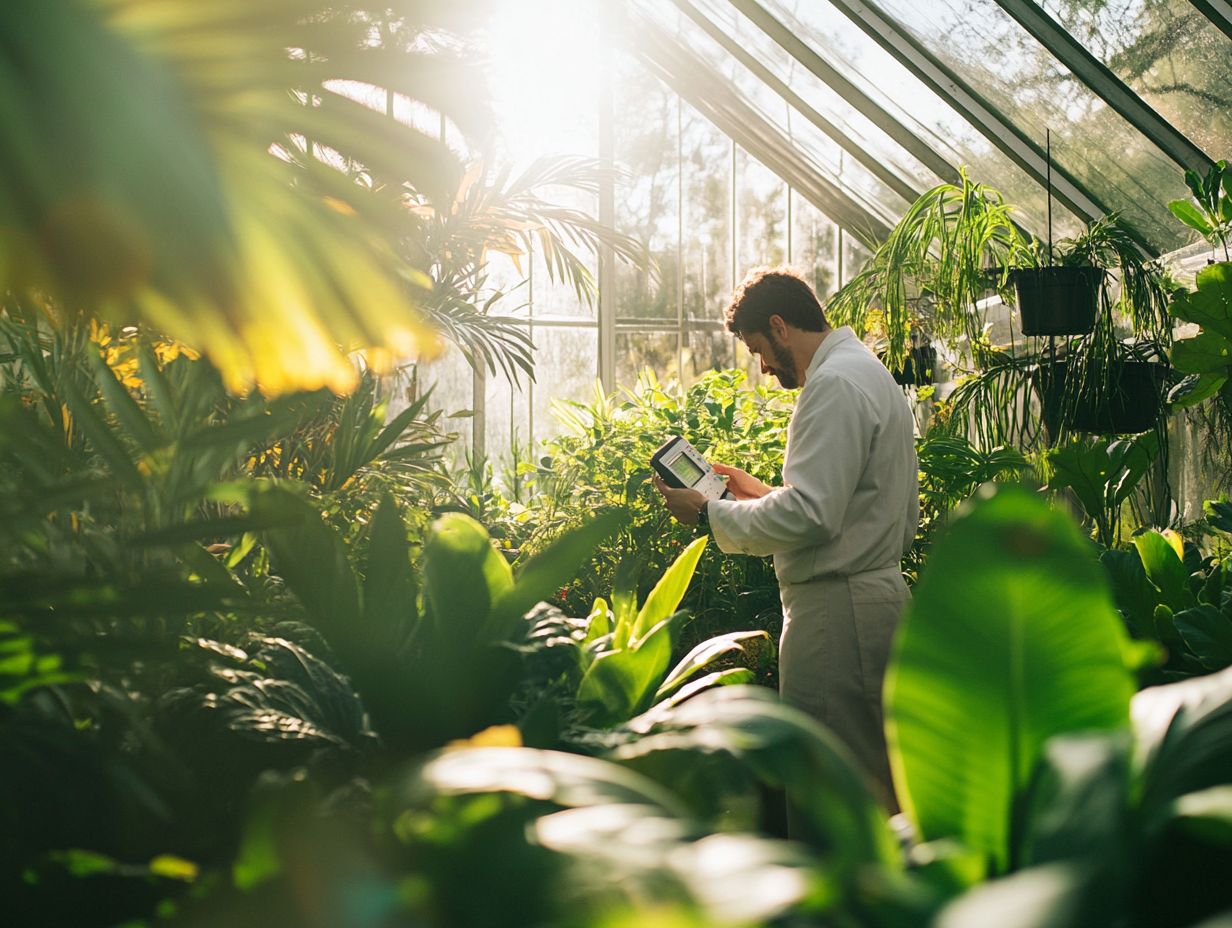
- Light intensity is vital for plant growth, significantly influencing photosynthesis and other physiological processes.
- Factors such as light spectrum, distance, and duration affect light intensity. Understanding and measuring these accurately is essential.
- You can use light meters and DIY methods to measure light intensity, helping you adjust and maintain optimal levels for healthy growth.
Why Light Intensity is Important for Plants
Light intensity directly affects photosynthesis, the process through which plants convert light energy into chemical energy. Ensuring optimal light exposure is fundamental for healthy plant development, especially for houseplants like the Fiddle Leaf Fig and succulents, which have specific lighting needs.
By understanding the importance of light intensity, you can transform your garden, allowing your plants to receive the energy they need to thrive.
Role of Light in Plant Growth
Light is essential for plant growth, acting as a catalyst for photosynthesis. This process relies on specific wavelengths within the PAR spectrum to drive energy conversion.
When plants absorb light energy, they convert carbon dioxide and water into glucose and oxygen key ingredients for their growth. Different wavelengths interact with plant pigments uniquely, influencing growth rates, flowering, and overall health. For example, blue light promotes lush vegetative growth, while red light is crucial during flowering and fruiting stages.
You can use artificial grow lights to replicate natural conditions and adjust light exposure to ensure your plants receive the ideal spectrum. Varieties like tomatoes and peppers thrive with a mix of red and blue light, while leafy greens such as lettuce prefer a balanced spectrum favoring blue wavelengths.
Factors Affecting Light Intensity
Several factors can impact light intensity, which affects how effectively your plants harness light for growth. These include environmental conditions, the type of light source, and the strategic placement of your plants.
Understanding Light Spectrum and Intensity
Understanding the light spectrum, including PAR and PPFD (Photosynthetic Photon Flux Density), as well as its intensity is crucial for effective plant care. Different plants thrive under specific light types, measurable with tools that calculate PPFD and other light measurement units.
This understanding begins with Photosynthetically Active Radiation (PAR), the range of light used by plants for photosynthesis, which is vital for their health. By monitoring PAR levels, you can create an environment that enhances plant vitality. Tools like the Apogee Quantum Sensor, Dr. Meter, or light meters allow for accurate assessments of light exposure in various areas of your garden. For more insights, refer to the article on understanding light quality for plants.
For example, shade-loving plants thrive in filtered light, while sun-loving varieties require intense, direct exposure. By regularly monitoring light conditions, you can tailor your gardening practices, ensuring that each plant species receives the specific light it needs to flourish.
In conclusion, understanding light intensity is vital for a successful garden. By applying the tips provided, including how to monitor light exposure for healthy plants, you’ll enhance your plants’ growth and overall health. Embrace your gardening journey with confidence!
Methods for Measuring Light Intensity
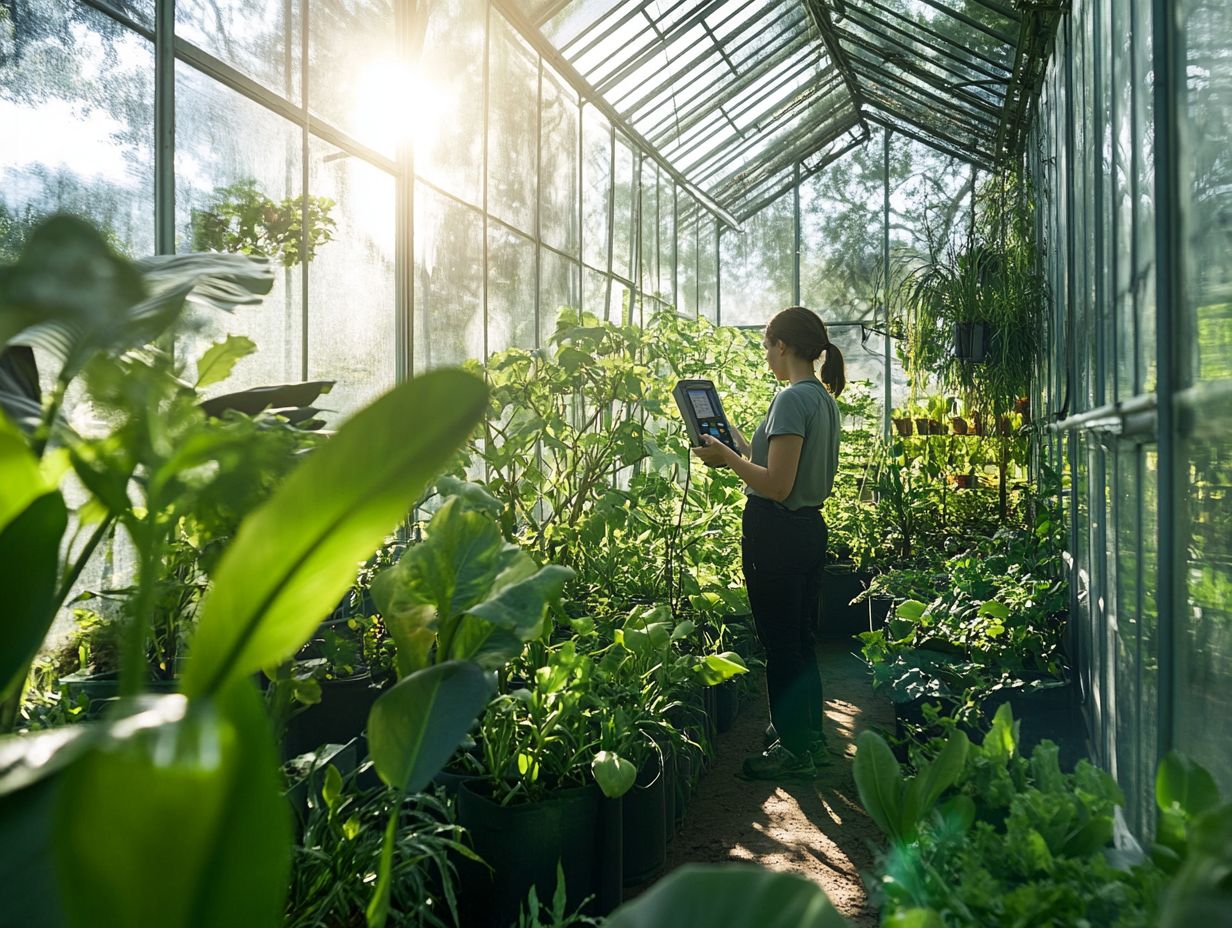
You have a range of effective methods for measuring light intensity, including light meter apps and physical light meters. Each method reveals crucial insights into the amount of light your plants receive.
Consider using light meters, illuminance meters, or even the sensors in your smartphone. These can provide valuable photosynthetic photon flux density (PPFD) measurements and other light readings.
Using Light Meters
A light meter is the go-to method for precise light measurements. It is especially useful for assessing PPFD and determining if lighting conditions align with the specific needs of your plants.
With various light meters available, including handheld, smartphone-enabled, and integrated models, you can find one that suits your gardening needs. Handheld meters are excellent for home gardeners and commercial operations, allowing detailed spot readings across different areas of your growing space.
Smartphone-enabled meters offer convenience and data tracking tailored to individual plant types. This ensures optimal placement for your plants.
To maximize these readings, assess light intensity and measurement units while comparing them to the known light requirements for each plant type. This approach allows you to make informed decisions about light adjustments and placement, fostering healthy growth. For detailed guidance, consider identifying light needs of various plants.
DIY Methods
If you enjoy a hands-on approach, using DIY methods to measure light intensity with everyday items or smartphone sensors can provide practical insights. This enhances your overall gardening efforts.
Knowing how much light your plants receive is crucial for their optimal growth, especially for low-light and high-light plants. Experimenting with these techniques can be enlightening and enjoyable.
Simple tools, like a homemade photometer or a smartphone app, can effectively gauge light intensity. For example, placing a piece of white paper in various spots around your garden can reveal valuable clues about sunlight distribution. Additionally, learning how to use light meters for plants can further enhance your understanding of light levels in your gardening space.
Combining these observations with soil moisture levels offers a comprehensive approach. To calibrate your methods, note the time of day and record your data consistently. This will help you identify patterns over time. This diligence guarantees your plants will thrive under the right conditions.
Interpreting Light Intensity Measurements
Interpreting light intensity measurements is essential for determining the ideal positioning of light for your plants. Understanding these measurements ensures each plant thrives according to its unique light requirements, as detailed in a comprehensive light requirements chart.
This attention to detail enhances their growth and vitality, helping you create a flourishing environment that meets all houseplant needs.
What is Considered Optimal for Plant Growth?
Optimal light exposure varies by species but typically falls within a specific range of intensity. This caters to each plant’s unique needs, ensuring they avoid light deficiency while promoting robust growth.
To achieve this delicate balance, it s crucial to understand the differences between low-light and high-light plants.
- Low-light varieties, such as snake plants and pothos, thrive in indirect sunlight. If they re exposed to too much brightness, watch for distress signals like leggy growth or faded leaves.
- High-light plants, like succulents and cacti, require direct sunlight to flourish. Without adequate light, they can exhibit stunted growth and lackluster color saturation.
By closely monitoring your plants for signs of light deficiency and adjusting their positions as needed whether moving them closer to a light source or providing supplemental grow lights you can significantly enhance their overall health and vibrancy.
Adjusting Light Intensity for Plants
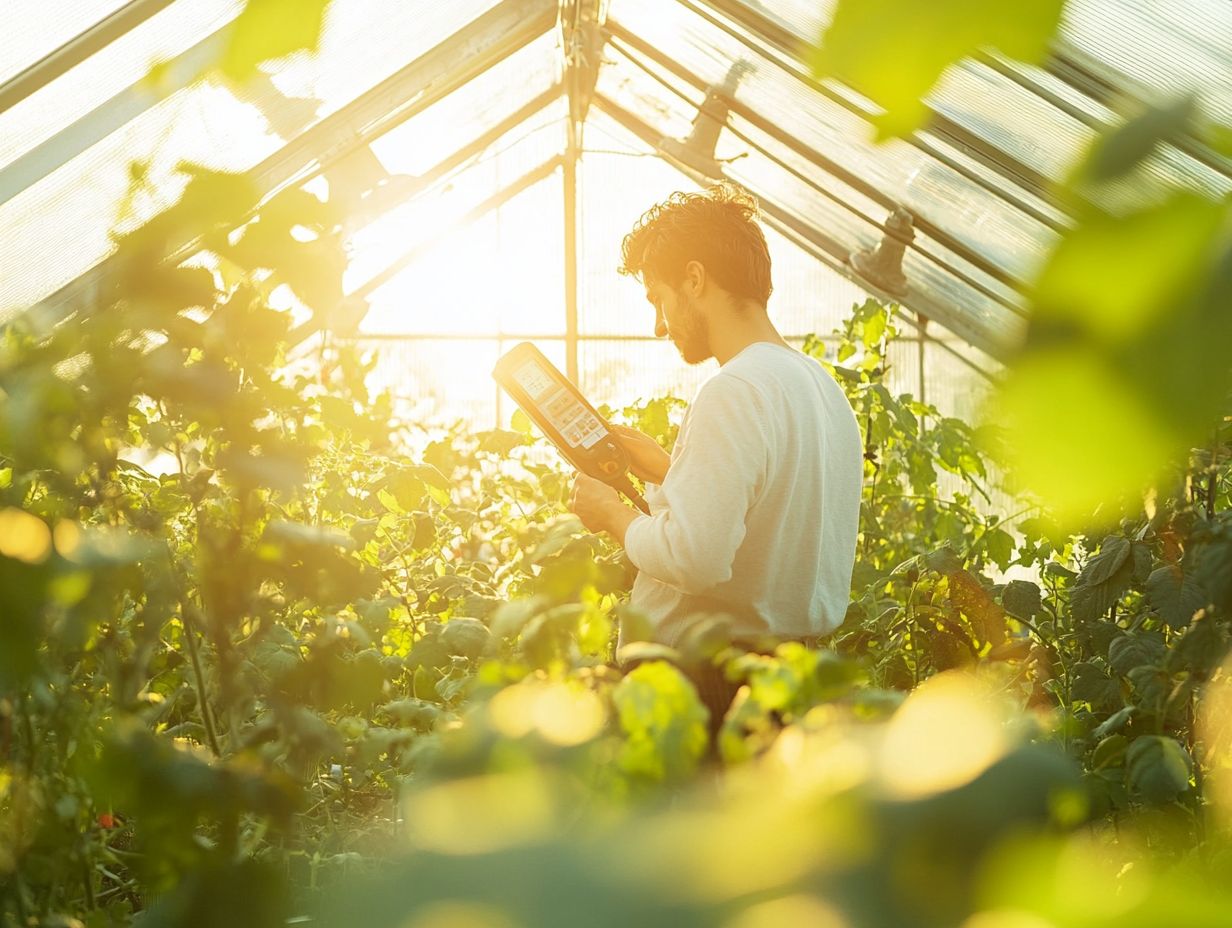
Adjusting light intensity is crucial for ensuring that your plants receive the optimal amount of light. You can achieve this through several methods, such as utilizing grow lights, using grow light meters, or fine-tuning their exposure to natural sunlight.
How to Increase or Decrease Light Intensity
Skillfully managing light intensity for your plants can involve various strategies:
- Repositioning plants.
- Adjusting your artificial lighting.
- Employing light diffusers to control exposure.
By moving your pots closer to windows or utilizing reflective surfaces, you can effectively increase natural light for sun-loving species. This can improve their overall placement. On the flip side, placing shade-sensitive plants further away from the light source allows them to thrive comfortably while ensuring their light exposure assessment is accurate.
For artificial lighting, opt for dimmable fixtures that let you adjust the intensity as seasons change. This helps prevent unnecessary stress for your plants. Heavy curtains or sheer panels can soften harsh sunlight, protecting delicate leaves from potential damage.
By carefully manipulating light levels, you can significantly influence photosynthesis rates, impacting your plants’ overall health and growth speed. For more insights, check out how measuring the effect of light on plant growth ensures optimal conditions for vibrant, thriving foliage.
Tips for Maintaining Optimal Light Intensity
To maintain optimal light intensity, engage in consistent monitoring and proactive management of your light sources. This helps your plants get just the right amount of light they need to thrive, especially during changing seasons.
Proper Placement and Maintenance of Light Sources
Proper placement and maintenance of light sources are essential for ensuring optimal light exposure. This profoundly impacts plants’ overall health and growth rates.
Understanding the specific requirements of various plant species is vital. Some thrive in bright conditions, while others prefer more subdued light. Position your lights at the right distances and angles to mimic the sun’s trajectory.
To maintain efficiency, regularly clean your light fixtures to eliminate dust. Check timers or sensors for peak performance. Keep an eye on sunlight patterns throughout the seasons to adjust natural light conditions. This ensures your plants receive adequate illumination for vigorous growth.
Frequently Asked Questions
What is light intensity and why is it important for plants?

Light intensity refers to the level of brightness or the amount of light hitting a certain area. It is important for plants because it affects their growth, photosynthesis, and overall health.
How can I measure light intensity for my plants using a physical light meter?
There are several ways to measure light intensity for plants:
- Use a light meter.
- Utilize a smartphone app.
- Create a DIY light meter using a cardboard box, a ruler, and a light sensor.
What is a good light intensity level for indoor plants?
Most indoor plants require a light intensity of 1000-2000 foot-candles. However, this may vary depending on the specific plant species. It’s best to research the recommended light intensity for your specific plant.
How do I use a light meter to measure light intensity for my plants?
To use a light meter, place it at the level of your plant and press the “read” button. The meter will give you a reading in foot-candles or lux, which are measures of light intensity. You can then compare this reading to the recommended light intensity for your specific plant.
Try adjusting your light sources today to see how your plants react!
Can I use a smartphone app to measure light intensity for my plants?
Yes, you can use several smartphone apps that utilize your camera and light sensor to measure light intensity. Adjust the app settings before use and take multiple readings to ensure accuracy.
How often should I measure light intensity for my plants?
Measure light intensity at least once a month. This ensures your plants receive enough light for healthy growth.
If your plants look droopy, grab your app and measure right away! Frequent checks can help you identify if light levels are affecting their health.

